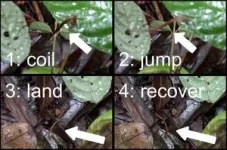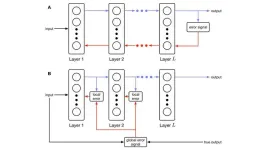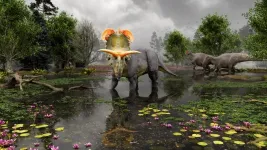(Press-News.org) A new study presents video evidence that at least one species of terrestrial leech can jump, behavior that scientists have debated for more than a century. Researchers from the American Museum of Natural History, Fordham University, and City University of New York (CUNY)’s Medgar Evers College published the footage and corresponding analysis today in the journal Biotropica.
“We believe this is the first convincing evidence that leeches can jump and do so with visible energy expenditure,” said lead author Mai Fahmy, a visiting scientist at the Museum and a postdoctoral researcher at Fordham University. “There have been previous accounts of leeches jumping, including onto people, but those reports were often explained away as leeches just attaching to passerby as they brushed against shrubs or dropping from a branch above. This study dispels that argument.”
During two separate expeditions to Madagascar in 2017 and in 2023, Fahmy recorded footage of leeches from the genus Chtonobdella coiling back on a leaf and then taking off. Fahmy and coauthor Michael Tessler, an assistant professor at CUNY’s Medgar Evans College and a research associate at the Museum, compare this motion to a “backbending cobra,” or to a spring being pulled back. In both cases, the leech keeps its body extended as it soars through the air to the ground, in a notable departure from their usual inchworm-like movements.
“Essentially, it executes a graceful jump but with a seemingly hard landing,” Tessler said.
Several other worm-like invertebrates can jump, including the legless larvae of gall midges (Asphondylia sp.), which assume a loop posture before propelling themselves into the air, the larvae of Mediterranean fruit flies (Ceratitis capitata), “skipper flies” (Prochyliza xanthostoma), and several caterpillars, including Lymantria monacha and Orgyia leucostigma. While naturalists and leech biologists have long argued about the ability of terrestrial leeches in the family Haemadipsidae to jump, with some making observations of leeches leaping in their travel notes, there has been little concrete evidence until now.
Fahmy collected the jumping leech she observed on the 2023 trip, and the researchers identified it as Chtonobdella fallax, a common species in Madagascar. The larger Chtonobdella group of leeches to which C. fallax belongs can be found across Madagascar, the Seychelles, the Malay Archipelago, and the South Pacific Islands.
“We do not know how often this may happen or whether these leeches use this ability to seek out hosts, but, given that we caught multiple jumps in two short recordings, this behavior may be common for this species,” said Tessler, who studied leeches extensively as a graduate student in the comparative biology Ph.D. program at the Museum’s Richard Gilder Graduate School.
Understanding overall leech behavior is also important to conservation efforts because leeches—and more specifically, their blood meals—are increasingly being collected to survey vertebrate biodiversity.
“If we can identify how leeches find and attach to hosts, we can better understand the results of their gut content analyses,” Fahmy said. “Leeches are also often overlooked and understudied, and, as a natural part of the ecosystem, leeches themselves may be in need of conservation protection.”
ABOUT THE AMERICAN MUSEUM OF NATURAL HISTORY (AMNH)
The American Museum of Natural History, founded in 1869 with a dual mission of scientific research and science education, is one of the world’s preeminent scientific, educational, and cultural institutions. The Museum encompasses more than 40 permanent exhibition halls, galleries for temporary exhibitions, the Rose Center for Earth and Space including the Hayden Planetarium, and the Richard Gilder Center for Science, Education, and Innovation. The Museum’s scientists draw on a world-class permanent collection of more than 30 million specimens and artifacts, some of which are billions of years old, and on one of the largest natural history libraries in the world. Through its Richard Gilder Graduate School, the Museum offers two of the only free-standing, degree-granting programs of their kind at any museum in the U.S.: the Ph.D. program in Comparative Biology and the Master of Arts in Teaching (MAT) Earth Science residency program. Visit amnh.org for more information.
END
First conclusive evidence that a terrestrial leech species can jump
Scientists publish footage of Madagascar Chtonobdella leeches jumping, rebutting previous doubts
2024-06-20
ELSE PRESS RELEASES FROM THIS DATE:
Creation of a power-generating, gel electret-based device
2024-06-20
1. A team of researchers from NIMS, Hokkaido University and Meiji Pharmaceutical University has developed a gel electret capable of stably retaining a large electrostatic charge. The team then combined this gel with highly flexible electrodes to create a sensor capable of perceiving low-frequency vibrations (e.g., vibrations generated by human motion) and converting them into output voltage signals. This device may potentially be used as a wearable healthcare sensor.
2. Interest in the development of soft, lightweight, power-generating materials has been growing in recent years for use in soft electronics designed for various purposes, such as ...
How E. coli defends itself against antibiotics
2024-06-20
When E. coli detects damage to its genetic material, it sends out an SOS signal that alters activity inside the cells.
“The bacteria go into full emergency mode,” says PhD candidate Olaug Elisabeth Torheim Bergum at the Norwegian University of Science and Technology (NTNU).
Imagine that you have a very sore throat. You're sick, your throat hurts, and a visit to the doctor confirms that the pain is due to a bacterial infection. You get a prescription for antibiotics, which quickly sorts out your sore throat. You are pleased that the treatment ...
Mental health leaders to gather for international summit on suicide prevention
2024-06-20
DETROIT (June 20, 2024)— Mental health experts from across the globe will gather to share insights, best practices, and innovations for preventing suicide during the 5th Zero Suicide International Summit June 24-25 in Liverpool, England.
Named for the innovative, evidence-based suicide intervention model developed at Henry Ford Health, the Zero Suicide International Summit is presented by the Detroit-based healthcare system in partnership with Zero Suicide Alliance (ZSA) and The Kevin and Margaret Hines Foundation.
The Zero Suicide model was developed at Henry Ford Health in 2001. Within a year of implementing the ...
Can AI learn like us?
2024-06-20
It reads. It talks. It collates mountains of data and recommends business decisions. Today’s artificial intelligence might seem more human than ever. However, AI still has several critical shortcomings.
“As impressive as ChatGPT and all these current AI technologies are, in terms of interacting with the physical world, they’re still very limited. Even in things they do, like solve math problems and write essays, they take billions and billions of training examples before they can do them well, " explains Cold Spring Harbor Laboratory (CSHL) NeuroAI Scholar Kyle Daruwalla.
Daruwalla ...
Changing climate will make home feel like somewhere else
2024-06-20
Changing climate will make home feel like somewhere else
Interactive app shows how climate change will make places around the world feel like they are closer to the equator
FROSTBURG, MD (June 20, 2024)—The impacts of climate change are being felt all over the world, but how will it impact how your hometown feels? An interactive web application from the University of Maryland Center for Environmental Science allows users to search 40,581 places and 5,323 metro areas around the globe to match the expected future climate in each city with the current climate of another location, ...
Newly discovered dinosaur boasts big, blade-like horns
2024-06-20
What do you get when you cross Norse mythology with a 78-million-year-old ancestor to the Triceratops? Answer: Lokiceratops rangiformis, a plant-eating dinosaur with a very fancy set of horns.
The new dinosaur was identified and named by Colorado State University affiliate faculty member Joseph Sertich and University of Utah Professor Mark Loewen. The dinosaur’s name, announced today in the scientific journal PeerJ, translates roughly to “Loki’s horned face that looks like a caribou.”
Loewen and Sertich, co-lead authors of the PeerJ study, dubbed the new species Lokiceratops (lo-Kee-sare-a-tops) ...
Exploring the relationship between civilians and military organizations through an experiment in Japan
2024-06-20
In democracies where civilian control is followed, the power to make crucial decisions, like those of national security, is mainly exercised by elected officials, allowing the citizens who elect them to influence such decisions indirectly. This role can give people a sense of participation in matters of national importance, potentially associated with their political trust. The military, in such cases, advises and helps these elected leaders in serving the nation, rather than assuming leadership itself. A balance between civilians and military organizations is, therefore, crucial for any democracy to thrive, and it is pointed out that civilian control is a requisite of democracy.
Existing ...
A simple, fast, and versatile method for selective bromination of indole alkaloids
2024-06-20
Indolo[2,3-a]quinolizidine is a common structural motif in various natural products. Its molecular structure contains the indole ring, a functional group in tryptophan. Tryptophan, an essential amino acid, is required for the production and maintenance of our body’s proteins, muscles, enzymes, and neurotransmitters. Many natural products are derived from it. Over 3,000 monoterpene indole alkaloids (MTIAs), which are natural products consisting of indole rings, have been found in plants, and some of them have been used as medicines. For example, vinblastine has been used as an anticancer drug, and reserpine is used to treat high blood pressure.
The ...
Removal of ovaries before menopause associated with reduced white matter in brain
2024-06-20
WINSTON-SALEM, N.C. – June 20, 2024 – Women who have their ovaries removed before menopause, particularly before the age of 40, have reduced white matter integrity in multiple regions of the brain later in life. White matter refers to the nerve fibers that connect neurons in different areas of the brain.
The findings appear online today in Alzheimer’s & Dementia: The Journal of the Alzheimer’s Association.
“We know that having both ovaries removed before natural menopause causes abrupt endocrine dysfunction, which increases ...
Fewer good gut bacteria increase the risk of serious infection
2024-06-20
The composition of the intestinal flora can predict the chances of developing serious infections such as pneumonia. Researchers from Amsterdam UMC and the University of Turku, Finland, followed more than 10,000 people for 6 years. More than 600 people who had less healthy intestinal flora developed a serious infection, with this leading in some cases to death. The results of the study are published today in The Lancet Microbe.
The 602 people who were hospitalised due to an infection showed at the start of the study that they had fewer butyrate-producing ...
LAST 30 PRESS RELEASES:
Heart-brain connection: international study reveals the role of the vagus nerve in keeping the heart young
Researchers identify Rb1 as a predictive biomarker for a new therapeutic strategy in some breast cancers
Survey reveals ethical gaps slowing AI adoption in pediatric surgery
Stimulant ADHD medications work differently than thought
AI overestimates how smart people are, according to HSE economists
HSE researchers create genome-wide map of quadruplexes
Scientists boost cell "powerhouses" to burn more calories
Automatic label checking: The missing step in making reliable medical AI
Low daily alcohol intake linked to 50% heightened mouth cancer risk in India
American Meteorological Society announces Rick Spinrad as 2026 President-Elect
Biomass-based carbon capture spotlighted in newly released global climate webinar recording
Illuminating invisible nano pollutants: advanced bioimaging tracks the full journey of emerging nanoscale contaminants in living systems
How does age affect recovery from spinal cord injury?
Novel AI tool offers prognosis for patients with head and neck cancer
Fathers’ microplastic exposure tied to their children’s metabolic problems
Research validates laboratory model for studying high-grade serous ovarian cancer
SIR 2026 delivers transformative breakthroughs in minimally invasive medicine to improve patient care
Stem Cell Reports most downloaded papers of 2025 highlight the breadth and impact of stem cell research
Oxford-led study estimates NHS spends around 3% of its primary and secondary care budget on the health impacts of heat and cold in England
A researcher’s long quest leads to a smart composite breakthrough
Urban wild bees act as “microbial sensors” of city health.
New study finds where you live affects recovery after a hip fracture
Forecasting the impact of fully automated vehicle adoption on US road traffic injuries
Alcohol-related hospitalizations from 2016 to 2022
Semaglutide and hospitalizations in patients with obesity and established cardiovascular disease
Researchers ‘listen in’ to embryo-mother interactions during implantation using a culture system replicating the womb lining
How changing your diet could help save the world
How to make AI truly scalable and reliable for real-time traffic assignment?
Beyond fragmented markets: A new framework for efficient and stable ride-pooling
Can shape priors make road perception more reliable for autonomous driving?
[Press-News.org] First conclusive evidence that a terrestrial leech species can jumpScientists publish footage of Madagascar Chtonobdella leeches jumping, rebutting previous doubts










